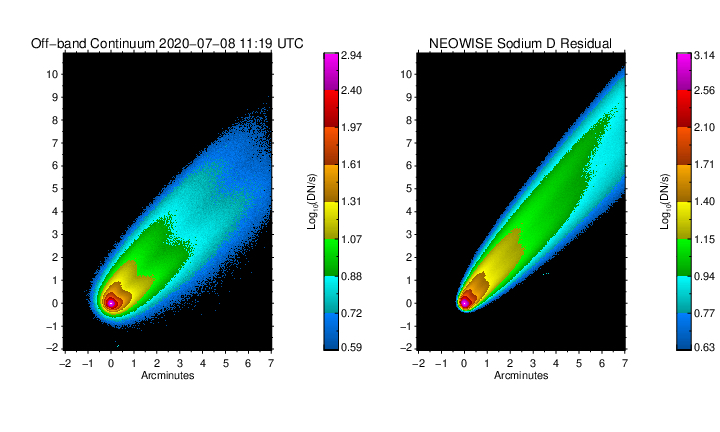Comet NEOWISE has a sodium tail. Here's what it looks like.

New images of the bright Comet NEOWISE show signs of a sodium tail, giving scientists fresh insight on what's happening on the surface.
Comet brightness is notoriously hard to predict due to the complexity of surface outgassing, so any insight into these surface processes is useful to scientists. NEOWISE, formally known as comet C/2020 F3, is relatively bright in the sky for Northern Hemisphere observers, but nobody knows how the comet's brightness will fare as it races away from the sun the sun and back toward the outer solar system.
Images of the comet were obtained on July 8 using the Planetary Science Institute's (PSI) Input/Output facility, which has also spotted sodium in Mercury's comet-like tail as well as Jupiter's atmosphere during past observations.
Related: How to see Comet NEOWISE in the night sky this month
More: Amazing photos of Comet NEOWISE from the Earth and space
NEOWISE and comets like it are made of dust, gas and plasma (ionized gas). As comets rocket toward the sun from interstellar space or the outer solar system, sunlight causes ice in the comet to turn directly into gas (or sublime). As the ice gasses away, it pulls material from the comet's surface with it.
Scientists can already get a sense of cometary activity by looking at the dust coming from a comet, which can move faster if the particles are tiny and more easily pushed by sunlight. Slower particles tend to be larger and harder to move around. These individual particles affect how the dust tail is shaped.
Like dust, atomic sodium also is affected by sunlight, although it has more specific changes.
Get the Space.com Newsletter
Breaking space news, the latest updates on rocket launches, skywatching events and more!
"Its [atomic sodium's] momentum kick comes from a very particular wavelength of yellow light — the same color seen in sodium vapor street lamps," research team member Jeffrey Morgenthaler, a PSI senior scientist, said in a statement.
"Thanks to acceleration by intense sunlight," co-author and Boston University research scientist Carl Schmidt added in the same statement, "the sodium tail takes on a different shape than the tail seen in off-band filtered images, which are dominated by reflected light from dust. In comparison, the sodium tail is narrower, longer and points directly away from the sun."
Sunlight's push on sodium atoms tends to be stronger than its effect on dust and other gases that come off comets. It is difficult to see sodium tails, however, due to the sun's emissions. Notable examples of comets with sodium tails include Hale-Bopp (the famed 1997 naked eye-comet) and the notorious Comet ISON, which fell apart shortly after rounding the sun in 2013.
Morgenthaler and Schmidt will continue to observe NEOWISE as it rounds the sun. They are also using Monte Carlo computer models to simulate the sodium tail and estimate outgassing rates and speeds.
It was not revealed in the statement exactly when the team plans to submit their results to a journal for peer review, but it is common when observing quickly changing astronomical phenomena like NEOWISE to release interim information to keep the community informed.
Editor's note: This story has been updated to included a corrected photo of Comet NEOWISE supplied by the research team.
Follow Elizabeth Howell on Twitter @howellspace. Follow us on Twitter @Spacedotcom and on Facebook.
Join our Space Forums to keep talking space on the latest missions, night sky and more! And if you have a news tip, correction or comment, let us know at: community@space.com.

Elizabeth Howell (she/her), Ph.D., was a staff writer in the spaceflight channel between 2022 and 2024 specializing in Canadian space news. She was contributing writer for Space.com for 10 years from 2012 to 2024. Elizabeth's reporting includes multiple exclusives with the White House, leading world coverage about a lost-and-found space tomato on the International Space Station, witnessing five human spaceflight launches on two continents, flying parabolic, working inside a spacesuit, and participating in a simulated Mars mission. Her latest book, "Why Am I Taller?" (ECW Press, 2022) is co-written with astronaut Dave Williams.









